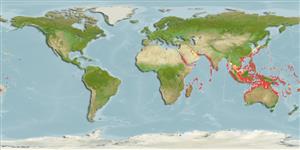Common names from other countries
Environment: milieu / climate zone / depth range / distribution range
Ecologia
marino associati a barriera corallina; distribuzione batimetrica 0 - 55 m (Ref. 26165), usually 5 - 35 m (Ref. 27115). Tropical; 22°C - 28°C (Ref. 27115); 35°N - 36°S, 24°E - 169°W
Indo-West Pacific: Red Sea and Natal, South Africa to Niue (Ref. 37816), north to Japan, south to Australia. Recorded from Europa Island (MNHN 1992-0508).
Size / Peso / Age
Maturity: Lm ? range ? - ? cm
Max length : 15.0 cm TL maschio/sesso non determinato; (Ref. 9710); 7.0 cm TL (female)
Spine dorsali (totale) : 10; Raggi dorsali molli (totale) : 15 - 17; Spine anali: 3; Raggi anali molli: 6 - 7. Color patterns vary from one locality to another.
Adults are found above coral outcrops or patch reefs of clear lagoons, channels, or outer reef slopes. Form large aggregations. Feed on zooplankton (Ref. 6113). A protogynous hermaphrodite (Ref. 55367). Males are territorial and haremic (Ref. 9710). Color patterns and size of sexual transition very slightly from one locality to the next. Total length for females from Ref. 9137.
Life cycle and mating behavior
Maturities | Riproduzione | Spawnings | Egg(s) | Fecundities | Larve
Pelagic spawner. A monandric species (Ref. 55367). Females are induced to change sex by removal of males from social groups (Ref. 38802). Sex-reversal is completed in 2-4 weeks after male removal in the area, or 170-280 days in an all female group (Ref. 34185, 34249, 34250). Length at sex change = 5.0 cm TL (Ref. 55367). Also Ref. 103751.
Successful males spawn nightly with successive females (Ref. 37816).
Randall, J.E., G.R. Allen and R.C. Steene, 1990. Fishes of the Great Barrier Reef and Coral Sea. University of Hawaii Press, Honolulu, Hawaii. 506 p. (Ref. 2334)
IUCN Red List Status (Ref. 130435)
CITES (Ref. 128078)
Not Evaluated
Threat to humans
Harmless
Human uses
Pesca: scarso interesse commerciale; Acquario: Commerciale
Strumenti
Special reports
Download XML
Fonti Internet
Estimates based on models
Preferred temperature (Ref.
115969): 24.3 - 28.9, mean 27.6 (based on 1000 cells).
Phylogenetic diversity index (Ref.
82804): PD
50 = 0.5000 [Uniqueness, from 0.5 = low to 2.0 = high].
Trophic level (Ref.
69278): 3.4 ±0.45 se; based on food items.
Resilienza (Ref.
120179): Alto, tempo minimo di raddoppiamento della popolazione meno di 15 mesi (K=0.6).
Fishing Vulnerability (Ref.
59153): Low vulnerability (23 of 100).
